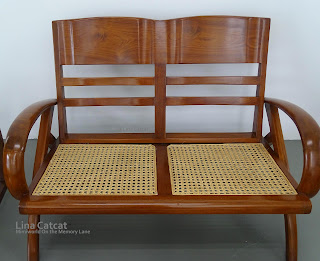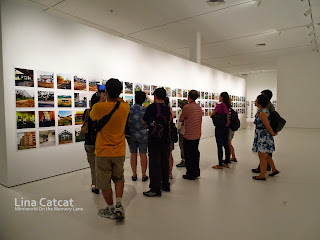50Plus Expo 2015@ Suntec
This year Council of the Third Age (C3A) hosted 50Plus Suntec Expo (Jubilee Edition) this month on the 15th to 17th of May 2015 (3 days event) for SG50. I did my registration earlier in April 2015 and need not to re-registered for the month of May because it postponed due to the passing of the late Mr Lee Kuan Yew's state funeral from 23rd to 28th April 2015. I had been to C3A events yearly and my nostalgic friends are the selection of the participants of the 'Forum Talks' and others like Dick Yip who hosts for his 'Ukulele' sings along and teach visitors how to play and encourage them to join their singing sessions. It's never too old to learn things while you can as long as your heart is still young.
Enjoy section@50Plus Expo 2015
My hubby and I were specially invited by James Seah even though I missed the chance to register as it is FULLY BOOKED!! Yet I thanked James for allowing me and my hubby to access to shoot videoing for him as he wanted me to help him. This is not the 1st time I helped him though, I giggled.
Before we reached to the Suntec Expo for C3A forum talks, we went for our lunch at the 'Kopitiam' at the basement of Suntec Convention at 1 plus in the afternoon as James Seah's forum talks starts at 3pm but we have to meet him at 2.30pm earlier to prepare my gadgets.
James Seah's forum talks is about 'Reviving Memories of Singapore through Blogging' to encourage people from older generations to blog and share their old memories of the good old days to their children and grandchildren. It's never too late to learn things as long as they are still alive and healthy.
Dick Yip, Me and his Friends of Yesteryears
The Ukulele Team
We went up to the 4th level to look for my Foyers where he and his team played solo songs using his Ukulele to strumming away. To attract more people to come forward to listen his songs and learn to sing with him. I thought I was one of them and listening to one of his favourite songs, I giggled.
Learning Calligraphy
Many old folks and even older generations came despite of their busy schedules with their families for as long as their children would bring their aged parents/grandparents along to attend the event once every year. There are lots of games, free courses to choose from, learn calligraphy, Clay Art, foodfare counter to try to taste the 'free' dishes e.g. kueh and fried rice specially cooked by well known chef.
Foodfare counter
At foodfare counter, you can try the food samples.
Mini Clay Cupcakes
Mini Clay Fortune God
The free courses for seniors are part of the SG 50 Seniors package, a package presented by the Ministerial Committee on Ageing.
Ryan Sim and James Seah
Upon checking the time, oh my gosh, it's getting late. As we had to meet James Seah and Ryan Sim (Staff C3A) at 2.30pm at level 3 before the start of the talks so that I can set up my 'video' camera with a tripod for recording of his talks on stage.
Set up for videoing
After setting up, I have to sit on the chair, just in front of my 'video' camera facing the stage. My 'video' camera started on recording for about 45 mins. Actually each forum speaker is given an hour talk on his/her topic.
James Seah at Forum Talk
Gain insights and knowledge on topics most relevant for active agers with a series of educational and informative forum talks. Admission is free but registration is required at Forum Registration Counter (next to Meeting Room 323, Level 3). For the First 100 persons attending (each session) will receive a goodie bag at the end of the talk!
Forum Talks on One of the topics
My nostalgic friend, Mr James Seah invited me and my hubby for his talks and reserved seats for us. And I helped him to record a video for his talks using my Sony camera at 3.00pm talks. You may wish to listen to his talks if you have missed it. Click to "Forum Talks".Reviving Memories of Singapore through Blogging
Mr James Seah
Blogger in pursuit of active ageing
Mr James Seah will share ideas on how to start a nostalgia blog – by tapping on online resources to post old photos as 'memory aids' and share collective memories.
Chen ShuCheng and the host
After the end of the talk, we got the free "goodies" and went up the 4th level to look around again and spotted the local MediaCorp Artiste - Chen ShuCheng" on the stage and the host.
Sing along "Singapore Cheer" with Shu Sheng
Minuties later, a local MediaCorp artiste "Chen ShuCheng" joined them sang a song along with senior citizens, visitors, young or old alike. The song as below:
Singapore Cheer
(clap-clap) (clap-clap-clap)
(clap-clap-clap-clap) (clap-clap)
(clap-clap) (clap-clap-clap)
(clap-clap-clap-clap) (clap-clap)
Say it loud, make it clear
Shout the Singapura cheer!
Go Singapore!
S (clap) I-N (clap) G-A-P-O-R-E! (clap-clap-clap)
S (clap) I-N (clap) G-A-P-O-R-E! (clap-clap-clap)
We are Singapore! Yeah!
(clap-clap) (clap-clap-clap)
(clap-clap-clap-clap) (clap-clap)
(clap-clap) (clap-clap-clap)
(clap-clap-clap-clap) (clap-clap)
Say it loud, make it clear
Shout the Singapura cheer!
Go Singapore!
S (clap) I-N (clap) G-A-P-O-R-E! (clap-clap-clap)
S (clap) I-N (clap) G-A-P-O-R-E! (clap-clap-clap)
We are Singapore! Yeah!
There were other local celebrities like Mark Lee and Suhaimi Yusof (17 May - 3pm).
So get up close and personal with local celebrities and join them in the Singapore Cheer!
Chen ShuCheng and Me
Luckily, Chen ShuCheng and I posed for the photo on stage! 50plus EXPO 2015 was celebrating Singapore's golden jubilee!





























































